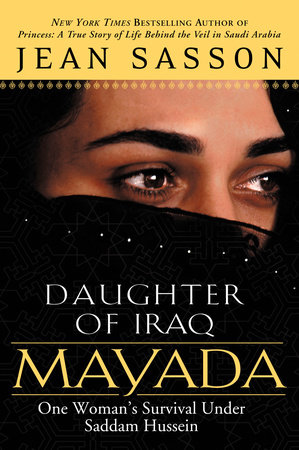READERS GUIDE
Questions and Topics for Discussion
INTRODUCTION
A member of one of the most distinguished and honored families in Iraq, Mayada grew up surrounded by wealth and royalty. But when Saddam Hussein’s regime took power, she was thrown into cell 52 in the infamous Baladiyat prison with seventeen other nameless, faceless women from all walks of life. To ease their suffering, these “shadow women” passed each day by sharing their life stories. Now, through Jean Sasson, Mayada is finally able to tell her story—and theirs—to the world.
ABOUT JEAN SASSONJean Sasson is a writer and lecturer who has lived in Saudi Arabia and traveled extensively in the Middle East. She is the author of four internationally bestselling books on the Middle East, including The Rape of Kuwait, Princess: A True Story of Life Behind the Veil in Saudi Arabia, Princess Sultana’s Daughters, and Princess Sultana’s Circle. Jean now lives in the deep South, although she still visits the Middle East frequently.
DISCUSSION QUESTIONSFor what “crime” was Mayada thrown into prison? In what ways did her ownership of a printing business make her suspect to the Iraqi government?
Even though she knows she has done nothing wrong, why does Mayada go with the government officials relatively easily?
Compare the methods and process for arrest and arraignment between your culture and that of Mayada. In what was are they different? Are there any similarities?
While anyone facing an arrest may be frightened of what lies ahead, why is the fear of arrest greater for Iraqis and specifically for Mayada?
In what ways was Mayada’s family important to the foundation and history of Iraq? How did her family’s influence change with the arrival of the Baath regime?
Because Mayada’s family played such a significant role in Iraqi history, they enjoyed some privileges under the Baath regime. What were some of those privileges? Were there any ways where this privilege became a disadvantage?
At what point did the life of privilege end for Mayada and her family? Did it every completely end?
What is the significance of the number “52”? How does Mayada let this control her emotions? Has there ever been a time when a belief such as this has had an effect on your life?
Who are the shadow women and what are their “crimes”? Is their imprisonment any more or less acceptable than Mayada’s?
In what ways was torture instituted by Saddam Hussein and the Baath government used as a mechanism for control of the Iraqi population?
Who do you think suffered more under the reign of Saddam Hussein, the wealthy or the impoverished? The supporters of the Baath party or those that were against the government? What types of suffering did each group have to endure?
In what ways does Iraq’s past mirror the present? What could this foretell for the future of Iraq after the removal of Saddam Hussein?
What is a takreem? Why is Mayada the recipient of this several times in her life? In what ways is this a tool used by the Iraqi government?
Describe Sajida (Saddam’s wife) and her life of privilege. How is her position and privilege different from that of Salwa and the rest of Mayada’s family?
In what ways did Ali Hassan Al-Majid’s (Chemical Ali) egocentrism both mimic and mock Iraq, its government, and its people?
What led Mayada to adopt more conservative Islamic practices such as wearing a veil? Why would this be a strong statement for Mayada? Why would her mother be opposed to this change?
Describe Dr. Fadil Al-Barrak and the conflict in his personality when dealing with personal matters and when dealing with his position in the government. In what ways did they coincide?
When discussing her family’s relationship with Dr. Fadil Al-Barrak, Mayada says, “I am being punished for remaining here [Iraq] with my mother. The Al-Husri presence lent credibility to Saddam’s government, on Sati’s behalf.” What would lead Mayada to believe this? Is there any credibility to this statement?
Mayada and the other shadow women hear the qubaj bird singing on the morning Mayada learns of her release. What does this signify? How does this compare to Mayada’s belief about the number 52?
As Mayada is being led away from Baladiyat, Samara is being led in a very opposite direction. How is this symbolic of the entire reality of the shadow women of cell 52?
How would you characterize Mayada? Is she a hero? An everyday Iraqi woman? Is she any different from the other prisoners at Baladiyat?
This book is about the life and imprisonment of Mayada Nizar Jafar Al-Askari. At what point was Mayada truly imprisoned? At what point was Mayada actually feed from her imprisonment?
Why do you think Mayada would want this story made public?
Then following is a list of characters central to the telling of Mayada’s story. Pick several of them to compare based on the following criteria: How their life has been affected by elements modern Iraqi history and how they handled the situations or positions they were in as a result of these elements.
Mayada, Saddam Hussein, Samara, Salwa (mother), Dr. Fadil Al-Barrak, Dr. Sabah, Nizar (father), Sajida (Saddam’s wife), Muna, Sati (maternal grandfather) Ali Hassan Al-Majid, Jamila, Jafar (paternal grandfather) and other shadow women.

